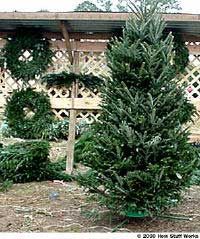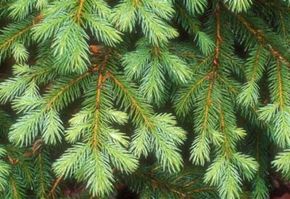Christmas Trees at a Glance
Where you live can dictate, to some extent, what type of tree you will select. For example, if you live in the Pacific Northwest, it's highly likely that you will have a Noble or Douglas fir. If you live in a southeastern state, let's say North Carolina, you will probably choose a Fraser fir, or possibly a white pine. However, with mail-order and online shopping growing in popularity among the Christmas tree industry, you aren't limited to what grows in your area.
Colorado Blue Spruce
Used as an ornamental landscape tree, the Colorado Blue Spruce makes an excellent living Christmas tree. Blue-gray to silvery-gray in color, this tree grows in a natural conical shape. Although this tree is primarily grown in southeastern Canada and the northeastern United States, you can probably locate one at a local retail lot or nursery.
Advertisement
Arizona Cypress
This tree has a steeple shape and is pale-green to gray-green in color. This is an aromatic tree that can most often be purchased at cut-your-own Christmas tree farms along the east coast and in the south and southwest regions of the United States.
Balsam Fir
Balsam's are pyramid shaped and dark-green in color with long-lasting needles. This fragrant tree is popular in Canada and throughout the northern United States.
Douglas Fir
Pyramid shaped and dark-green or blue-green in color, this tree has a subtle sweet fragrance. One of the most popular Christmas trees in the United States. Primarily grown in the Pacific Northwest, these trees are shipped throughout the United States and internationally to some Asian markets.
Fraser Fir

Pyramid shaped, the strong, upward-turned branches are densely covered with two-toned needles. The top side of the needle is dark-green to dark blue-green in color and the bottom side has a silvery appearance. Excellent needle retention, a pleasant aroma, and it's color make this one of the most popular Christmas tree species. Heavy ornaments and lights are easily held by this strong tree. The majority of Fraser Firs are produced in North Carolina and are shipped throughout the United States and internationally. The branches are also used to make wreaths, swags and Christmas roping.
Noble Fir
This tree is also pyramid shaped, with blue-green needles that give it a silvery appearance. The sturdy branches and long-lasting freshness make this a great Christmas tree. Like the Fraser fir, the greenery from this tree can be used to make wreaths, swags and garland.
Eastern Redcedar
Natural cone shaped, this tree can range in color from shiny dark-green to blue-green and even purple and are most usually available at cut-your-own Christmas tree farms or plantations. This tree can dry out quickly, so be sure to get the stump in water as soon as possible. The wood from this tree has been used in cedar chests and closets.
Leyland Cypress
This tree has an Impressive cone shape with colors that range from dark-green to gray. Although you will most often see this as an ornamental landscape plant throughout England and the southeastern United States, it has recently become popular as a Christmas tree in the southeastern United States. This is not a fragrant tree, so for those of you who don't like the "Christmas tree smell," this would be a good choice.
Virginia Pine
This pine tree is conical shaped. The soft, short needles are supported by stout woody branches, making this a good tree for ornaments. Normally dark-green in color, the needles can turn a yellowish-green in late fall, making it necessary to use a tree colorant or pigment to restore the natural color. Originally, this was the staple of the Christmas tree industry throughout the southeastern United States. This tree is available at retail lots and cut-your-own farms.
Scotch Pine
Nice conical shape. Color ranges from bright to dark green and sometimes blue-green. Sturdy branches, excellent needle retention, and lasting freshness make this a great Christmas tree. Don't worry about hanging heavy ornaments and lights on this tree.
Norway Spruce
This spruce is conical shaped. Dark green in color. This tree is not known for good needle retention, so make sure you get a fresh cut and keep it watered.
Eastern White Pine
An impressive cone shape, the soft needles on this tree are blue-green to silvery-green in color. Heavy ornaments do not work well on this tree. Sometimes the needles can turn yellow, so a tree colorant or pigment is used by the growers to restore trees to their natural color. This tree has very little fragrance and is reported to be less of an allergen than some of the more fragrant trees.
In the next section, we'll talk about looking for freshness in your Christmas tree.
